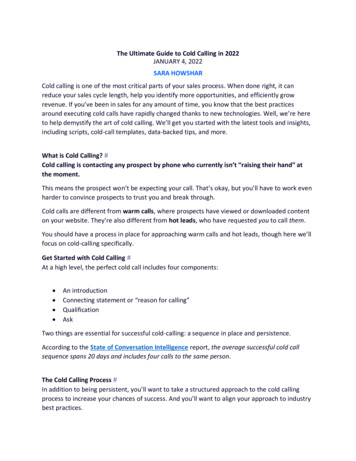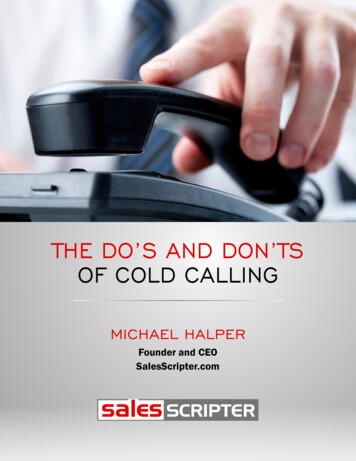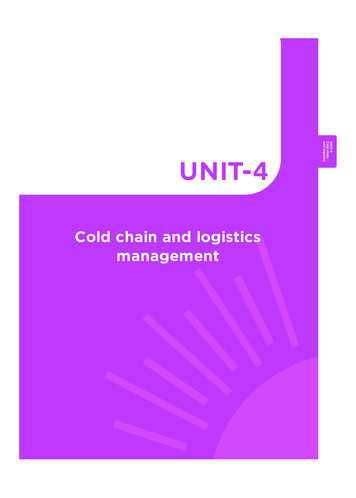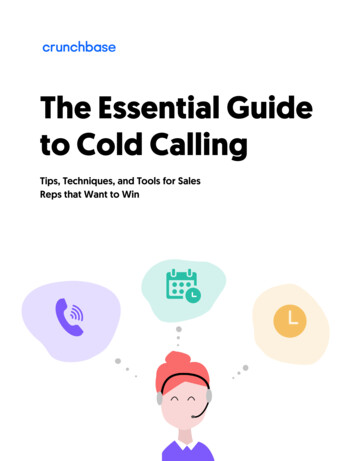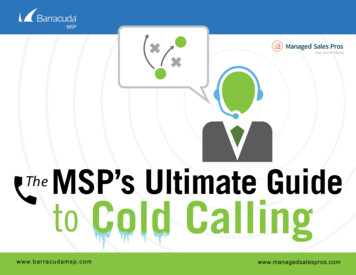
Transcription
REPORT 14International cold callinginvestment scamsJune 2002
InternationalCold CallingInvestmentScamsJune 2002“. these telemarketingscams have cheated manythousands of investors andhave been the subject ofinternational attention”
Find all ASIC’s financial tips andsafety checks for consumers andinvestors at www.fido.asic.gov.auOrder copies of our publication Don’t KissYour Money Goodbye through ASIC’s Infoline.Email: infoline@asic.gov.au orPhone: 1300 300 630 Australian Securities and Investments Commission 2002GPO Box 9827 in your capital city.www.fido.asic.gov.auASIC Infoline: infoline@asic.gov.au, phone: 1300 300 630
Contents1 EXECUTIVE SUMMARY42 REGULATORY PROPOSALS71.2.3.4.Education and warningsInternational regulatory actionDomestic regulatory actionASIC's powers77883 BACKGROUND & OBJECTIVES9Cold calling activityASIC's involvementThis report910104 WHAT IS THE EXTENT OF THE COLD CALLING PROBLEM?Proliferation of cold callersVictims of cold callingAmounts spentNumber of victimsGeographical spread1111121213135 HOW DO COLD CALLING SCAMS WORK?Cold calling scamsCold calling scams under Australian lawIllegal unlicensed brokersFalse, deceptive and/or misleading information and conductConsumer recourse and protection6 INVESTMENTS OFFERED IN COLD CALLING SCAMS:WHAT ARE THEY & WHERE ARE THEY LOCATED?Risky US over-the-counter (OTC) stock'Attractive' companiesMatters of timingInvestor paymentsSale restrictions1141419192023252527282930
7 WHO IS BEING TARGETED BY COLD CALLINGOPERATIONS & WHY?Who cold callers choose to targetInternational reachNation-wide exposureASIC cold calling survey demographicsGenderHow cold callers obtain people's contact detailsWhy Australians make likely targets31313131323334348 WHY DO SOME CONSUMERS FALL FOR COLD CALLING SCAMS? 36Key findingsThe scamMajor themes for why people investedImplications9 ACTION BY ASIC AND OTHER REGULATORS1. Response to enquiries and complaintsFormal response to consumersFormal response to cold callersAdditional responses2. Public warnings and educationMedia campaignsWebsite alerts and informationConsumer research3. Ongoing work with overseas regulatorsHelping overseas regulatorsRequesting assistance from overseas regulatorsIOSCO initiatives4. Enforcement actionAction against cold calling individualsAction against cold calling operationsInvestigations into Australian connectionsConstraints on ASIC 505051
10 REFERENCES5211 APPENDIX A53List of Australian laws contravened by overseas cold calling operations 5312 APPENDIX B54List of unlicensed international cold calling firmsknown to ASIC to date13 APPENDIX C5456IOSCO press release about international cold calling14 APPENDIX D5658List of press releases issued by ASIC about cold calling15 APPENDIX E5859Information about ASIC5916 GLOSSARY613
1Executive summaryBackground & objectivesThis report examines a recent and particularly wide-reaching internationalscam, share investment cold calling. This scam has affected many thousandsof investors and has been the subject of international regulatory attention.ASIC is seeking to highlight the problems of investment cold calling throughthis report. While investment scams are not new, they are increasinglyinternational in their scope, which poses significant challenges for regulators.The cold calling problem outlined in this report offers some importantlessons that should help reduce the impact of future scams. This report offersrecommendations designed to help prevent investors getting caught in theserorts, and to help regulators deal with current cold calling activity and futurescams.What is the extent of the cold calling problem?Since 1999, ASIC conservatively estimates that these cold calling investmentscams have cost Australian investors around AUD400 million dollars. This ismoney that could otherwise have been productively invested in Australia.Although it is hard to determine accurately, global losses could be in thebillions of dollars.More than 7,300 people across Australia have contacted ASIC about a coldcalling experience since 1999, and most (around 80%) have lost money. Thefull extent of this problem is even greater as not every case gets reported.People do not always immediately realise they have been cheated, and theymay feel too embarrassed to tell anyone. ASIC has identified at least 82 coldcalling firms, and that number is still rising. Often investors purchase severalstocks, and some are caught in secondary scams.How do cold calling scams work?Overseas cold calling operators make unsolicited phone calls, falsely claimingto be large international brokers offering shares in overseas companies toAustralian consumers. Although typically based in Asia, most operators arenot Asian nationals. They make false promises about the investments and usefake 'props', such as expensive documentation, to convince investors of theirlegitimacy. Their tactics are relatively sophisticated compared to scams suchas the "Nigerian Letters". The activity of the cold callers is illegal as theyperpetrate fraud on investors.Investors receive near worthless and/or restricted shares, or no shares at all.Once investors' money leaves Australia, it is almost impossible to recover.The operators are elusive, using 'virtual offices' to mask their true size,purpose and location, although some operations have been shut down.4
Investments offered in cold calling scams: What are theyand where are they located?Some victims of cold calling never received shares. Others received shares in'real' companies, but received none of the profits they were promised, andtheir shares instead turned out to be worthless or unsaleable. Of the realshares offered, most were stock trading on the speculative US over-thecounter (OTC) market.OTC stocks are prone to price manipulation in the sense that they do nothave an easily ascertainable market price. Retail investors in Australia canfind little reliable or independent information about OTC companies, and itis alleged that some OTC companies may even be run by, or have links with,the cold calling operators. When the cold callers stop promoting their chosenOTC stocks, the stock price drops and investors lose their money and cannotsell their shares.Who is being targeted by cold calling operations & why?All financially independent Australians are potential targets of cold calling.The best way to combat the scam is for consumers to protect themselves.Consumers need to know the risks of taking up unsolicited investment offersfrom unlicensed overseas organisations.All States and Territories and both metropolitan and regional areas have beenaffected. Although information about the targets of cold callers remainsinconclusive, ASIC's research suggested that business owners and managerswere popular targets. However, cold callers targeted many other groups aswell. Men are also much more likely to invest.Why do some consumers fall for cold calling scams?While some cold calling victims have not paid sufficient heed to the warningsigns in cold calling activities, ASIC's consumer research into cold callingfound that the cold callers frequently went to great lengths to build alegitimate image and a trusting relationship with potential investors. Theirtactics often proved successful.ASIC found some people became suspicious because they were called out ofthe blue, because the offer was based offshore or because a trusted thirdparty, such as ASIC or their financial adviser, warned them. But others sawcold calling as a legitimate sales technique, saw the offer as a convenient wayto enter a lucrative market, and ignored third party warnings. Unfortunately,in some cases third parties, such as friends, actually told investors theirinvestments would be safe.5
Action taken by ASIC and other regulatorsASIC has long been active against financial scams, such as the Australianbased "Wattle" scheme and the British Marine Bank scam in the 1990s.However, dealing with overseas-based scams is very challenging. ASIC startedpublic warnings against Asian-based cold calling activity in January 1999, inresponse to increasing complaints from the public. Because ASIC can enforceAustralian law only in Australian courts, its main protective efforts focussedon warning people not to deal with callers. ASIC issued regular media alerts,named the cold callers and set up a special cold calling section on its FIDOconsumer web site.ASIC has encouraged action by overseas authorities and cooperated withtheir enforcement actions. For example, Thai authorities raided two Bangkokcold calling premises in mid 2001. ASIC helped Thai and other overseasauthorities obtain statements from Australian investors for use in the Thaicourts.Although enforcement action is difficult in these cases, where cold callersvisit Australia ASIC has taken enforcement action. For example, Paul RichardBell (alias Dr Richard King), who worked for both International AssetManagement (IAM) and Trident International, was restrained from leavingAustralia and was subsequently convicted. ASIC also brought an injunctionagainst Garry Zinn, a representative of Alpine Pictures Inc, whose shares werepromoted by a cold calling operation.ASIC has also conducted research to help establish why consumers fall forthese scams so that it can help arm consumers against financial fraud.Proposals for future actionThis report presents proposals for regulatory action that ASIC has developedbased on its experience of these scams. These proposals are designed to betterequip it and other regulators to combat the current wave of cold callinginvestment scams as well as scams more broadly.Important notes The cold calling anecdotes featured in this report are based on thereal experiences of people who have contacted ASIC. However, insome cases, quotes have been edited for greater clarity. To ensureprivacy, investors' real names have not been used. Because of the complex and technical nature of cold calling scams(for example the legislative impacts and financial terms), thisreport offers detailed Appendixes and includes a Glossary for thereader to refer to when reading the report.6
Regulatory proposalsASIC will undertake the following actions, either alone or in cooperationwith other organisations, to continue its work against cold calling scams.1. Education and warnings1a. ASIC will maintain a special cold calling section on its consumerwebsite FIDO and promote this site actively. ASIC will look toexpand existing material on cold calling about Forex (foreignexchange) trading given the rise of scams in this area.1b. ASIC will direct education and warnings at investors targeted by coldcallers or those most likely to fall for cold calling scams, notablysmall businesses and professionals and male investors. For example,ASIC will target media outlets aimed at small businesses.1c. ASIC will seek to design an education project in consultation withAustralian financial services industry members concerning benefitsof retail investors dealing with licensed Australian entities shouldthey wish to invest offshore and the dangers of illegal, unlicensedcold calling.2. International regulatory action2a. ASIC will actively promote cross-border Regulatory proposals incooperation with its overseas counterparts, particularly in Asia. Thisincludes enforcement action, where possible, against Australiannationals involved in cold calling scams.2b. ASIC will approach US regulatory authorities to request that theyreview the operation of "Regulation S" and in particular that theyassess the possible abuse of this regulation in a manner whichfacilitates cold calling.2c. ASIC will approach the overseas regulatory authorities to assist ininvestigating possible links between overseas based investmentpromoters and cold calling operators.2d. As well as working with agencies in countries where cold callersoperate, ASIC will seek to work with agencies in jurisdictions thathave been the target of cold calling scams (e.g. South Africa, NewZealand) to help facilitate cross-border action.72
3. Domestic regulatory action3a. ASIC will hold talks with Australian-based banks and other relevantfinancial institutions on measures that may help prevent the transferof consumer money to overseas bank accounts known to be linkedto cold calling operations. Banks and other Deposit takinginstitutions will be given access information concerning bankaccounts known to be operated by cold calling firms. Financialinstitutions will be asked to consider ways in which informationwarning consumers about cold calling (developed by ASIC) can bedistributed to customers generally, or high risk classes of customers.3b. ASIC will make arrangements with Australian Federal Police andAUSTRAC to review and track cold calling activity so as to helpprovide early warnings about further scams.3c. ASIC will contact Australian-based courier companies that distributecold calling promotional documents to consumers to establishwhether there is any mechanism for establishing the origin and/orillegality of this material.4. ASIC's powers4a. ASIC will propose reforms that improve its capacity to: Facilitate restitution or compensation for the money sentoverseas by Australian investors to cold callers Obtain freezing orders in Australian courts against foreign bankaccounts in which investors' money has been traced (whether ornot the account contains other money) and assets acquired withthe proceeds of Australian investment monies Take criminal action against Australians involved in overseas coldcalling operations.These objectives may involve international cooperation and/orformal arrangements with overseas agencies to facilitate the retrievalof money and/or collection of evidence located offshore by ASIC.8
Background & objectives"Crime follows opportunity, and opportunities for fraud flow fromeconomic growth. The more commerce there is, the more opportunitiesthere are to commit fraud. Nobody wants to pull the plug on electroniccommerce [or] close down the stock market just because they may bevulnerable to fraud. Rather, the challenge lies in designing systems whichallow commerce to flourish while blocking opportunities for fraud. Thischallenges us to extend our ingenuity to counter that of villains, and tobuild smart systems" (Graycar and Smith, 2002: p1).Scams and fraud, including investment fraud, are not new, and have alwaysposed a challenge for regulators. However, ASIC is seeing increasingly diverse,sophisticated and internationalised investment scams, which mirror the growthin global commerce. This report details a recent and particularly damaging formof financial scam - overseas-based share cold calling. Since early 1999, when firstalerted to the growth in the problem, ASIC has issued warnings, informed andassisted the relevant overseas authorities and, where possible, taken enforcementaction. This report is part of ASIC's ongoing regulatory efforts against illegal coldcalling activity. The recommended Regulatory proposals are designed to assist inthe fight against scams more widely.Cold calling activityCold callers have found that their offers have, in recent times, found areceptive audience in Australia. It is important to consider why this hasarisen. In part, it is related to the unprecedented growth in participation ininvestment markets by retail investors in recent years. Factors such as anageing population, high profile sharemarket floats and compulsorysuperannuation have raised the average Australian's interest in investing.This development has many positives, but the swift rise in the popularity ofinvesting has arguably not been matched by a commensurate growth inconsumer knowledge. In this climate, Australian consumers are morevulnerable to scamsters intent on abusing their trust.Cold calling is simply an unsolicited approach by sales people to consumers.Much domestically based cold calling is legal, although the recentlyimplemented Financial Services Reform Act 2001 prohibits or restricts coldcalling activity of various types in the finance sector. The cold callersdescribed in this report are overseas organisations that pose as largebrokers/investment houses and approach investors, offering them shares inoffshore companies trading in foreign markets. Their activities are conductedoverwhelmingly via telephone, although supporting documentation is sentby facsimile, email and courier. Contrary to the impressive promises made bythe cold callers, investors are, at best, left with deflated shares in small 'startup' companies that are unlikely to get off the ground and, at worst, are leftwith nothing.Cold calling scams are not new and are not exclusive to Australia. Americancold calling "Boiler Rooms" have even been the subject of movies. However,public complaints to ASIC about the recent Asian-based scams have indicatedthat the current incarnation is particularly successful. In Australia alone, aconservatively estimated AUD400 million has been sent offshore to thesecompanies.93
Australia is not the only nation affected by this recent variation of coldcalling and, given the sum spent by Australian investors, global losses couldbe in the vicinity of billions of dollars. As a problem of international interest,it has been the focus of activities by (and cooperation between) various1regulators around the world.ASIC's involvementASIC was first alerted to the current, primarily Asian-based cold callingproblem in 1999, mainly through increasing complaints received from theAustralian public. People's concerns varied; from anger at the invasivepersistence of cold callers, to anxiety that they could no longer contact their'broker' and were unsure as to the status of their investment(s). As theAustralian financial regulator, ASIC was concerned by the risks these scamsposed to unsuspecting Australian consumers.Unlike many of the scams ASIC was already alerting the public about, thesescams appeared to be well organised and particularly convincing. For thisreason, and also because the overseas nature of the operations andinvestments pose certain regulatory constraints, ASIC has responded to coldcalling scams in a range of ways. This has included routinely warning thepublic via the media; setting up a detailed information section on its website; informing relevant overseas authorities of cold calling activity in theirjurisdiction; co-operating with some of these overseas authorities as part ofthe various investigations into specific cold calling operations; researchingconsumers' response to the activity; and undertaking enforcement actionagainst suspect individuals who have come within Australian borders.This reportThe information about the cold calling scams and proposals for further actioncontained in this report will help address the problem of international coldcalling. ASIC recognises that it cannot fix the cold calling problem alone, and theactivities of overseas authorities, other domestic regulators and in some casesfinancial services firms will be vital in fighting cold calling scams. Just asimportantly, consumers should be provided with as much relevant informationas possible about the operations and dangers of these scams so that they canprotect themselves. ASIC therefore continues to seek to highlight these issues forinvestors through the publication of such reports.The lessons learned by ASIC and other authorities in fighting cold calling activitywill assist in dealing with future scams that have an international dimension.While this current scam is primarily Asian-based and involves the marketing ofstocks, the next variant to hit Australia may be based in the US or Europe and2involve some other type of offer such as currency trading. This report providesinsight into the way the scams operate, reveals the breadth of their impact onAustralian consumers, and details the action taken by authorities so far. Itsultimate aim is to help protect Australian consumers and investors.12See Appendix C.The recent US-based Evergreen International Spot Trading scam (forex trading) that is under investigationin the US has fleeced Australian investors.10
What is the extent of thecold calling problem?AbstractIt is difficult to calculate the full extent of the cold calling problem. Oftenpeople take some time to realise they are being scammed and therefore donot immediately contact authorities. Although many people were alertedwhen, in July 2001, Thai authorities conducted raids on the premises ofseveral cold calling brokers and ASIC representatives spoke about the issue inthe general media, many more may still be unaware of the scam. Others mayfeel too embarrassed to contact authorities. However, at a minimum, ASICestimates that over the past three years: At least AUD400 million has been transferred offshore in these scamsover the last 3 years It is likely that billions of dollars worldwide have been lost on these scams More than 7,300 people have contacted ASIC about a cold callingexperience, with a considerable majority (around 80%) having lost somemoney. Over 28,000 hits have been made to ASIC's FIDO web site list ofcold call brokers Individuals who have contacted ASIC have spent between AUD1,500 to AUD3 million each in these scams, in many cases the sum of multipleinvestments People in every Australian State and Territory have been caught up in therorts, in both regional and metropolitan areas At least 82 cold calling 'broker' firms have targeted Australian investorswhile operating primarily out of a number of Asian countries such asThailand, Indonesia, and the Philippines Cold callers have offered investments in no fewer than 80 companies.Proliferation of cold callersKevin remembered this guy's voice from when The Kensington Group hadapproached him. He confronted him but he seemed genuine. After theraids, the caller told Kevin he'd left Kensington because they were dodgy.But now Kevin is having problems getting his share certificates fromInternational Asset Management too.Lou can't reach them. They've often changed their names and sound likethey're hiding.ASIC has identified 82 cold calling broker firms to date, all of which are3named on the ASIC web site cold calling list. This is not the actual numberof actual cold calling operations, but rather the result of the changing guisesof a smaller number of cold calling operators. Accordingly, some brokersoffered people shares in the same companies, and investors have reportedanomalies in caller behaviour, such as talking to a person they'd dealt withpreviously in a former firm. Combined, these brokers have offered shares inno less than 80 companies.3www.fido.asic.gov.au (select the Cold calling: o/seas offers by phone link then List of unlicensed overseascold callers). See also Appendix B.114
As mentioned earlier, they have operated out of several Asian countries and,as a subsequent section of this report reveals, they have targeted people allover the globe (see section, Who is being targeted by cold calling operations andwhy?).Victims of cold callingPeter was approached by five 'brokers'. He invested with all of themexcept one and lost about AUD160,000 all up, about half his assets and15 years worth of labour. For Peter it is the worst feeling - as bad as whenhis Mother died when he was young.Marcus borrowed against his mortgage for the first investment, and usedthe partial payment from his redundancy for the Orbit one.Amounts spentThe size of this scam became clearer in the wake of publicity after the raids inThailand in July 2001. Based on the money transferred to overseas bankaccounts, ASIC believes over AUD400 million has been spent by Australianinvestors in these particular scams and, though not the focus of this report,worldwide the scam may have fleeced billions of dollars. Some investors alsorecommended the brokers to their friends, family and/or colleagues whothen took up, or shared investments. Others made the investments alone,some without the knowledge of their spouses or other family members.Individually, those who have contacted ASIC have invested between AUD1,500 and AUD3 million each. The average amount spent by investors4who participated in ASIC's recent cold calling survey was AUD62,685. Inmany cases, these 'per person' investment figures were the sum of multipleinvestments.5Multiple investmentsOften investors were convinced to make several investments in severaldifferent securities and sometimes through several 'broker' companies. Whilesome thought this was being 'safe' (because they believed they were'diversifying' their investments), instead it only increased their overallexposure to the fraudsters. The circumstances under which multipleinvestments are made vary. Commonly, people make an initial investment of AUD5,000 to AUD10,000. Subsequent investments are often around AUD20,000 or AUD30,000. However, ASIC is aware of many investors whohave invested several AUD100,000 and a few who have invested more than AUD1 million. These trends reveal the success of the devices cold callersemploy, such as relationship building. Ironically, the very fact that investorswere asked to make multiple investments further convinced some that theywere dealing with genuine brokers.45The sample's median investment amount was AUD17,114 with a range of AUD3,900 to AUD500,000.For greater detail on this topic, please refer to HOOK, LINE & SINKER: Who takes the bait in cold callingscams? (ASIC, 2002), available from the FIDO web site: www.fido.asic.gov.au (under the Cold calling:o/seas offers by phone link).12
6Secondary scamsScammed investors are sometimes exposed to 'secondary scams'. An exampleis where an investor is told that a person or institution has an interest inbuying their shares at a premium to the current market price (because of taxadvantages for example). Investors who proceed are then told that they haveto pay a fee in order to have the restriction on the shares lifted. If they sendthe fee, they inevitably fail to receive any funds for their shares.Number of victimsPeople who have called ASIC's Infoline about cold calling appear to fall intothree main groups: many have already invested in the scams and are nowconcerned about their 'investments', some are looking for guidance as towhether to take up the offers, and others have rejected the offers but wish topass on the information to assist in making others aware. ASIC has receivedmore than 7,300 Infoline enquiries over a three year period, a figure that isundoubtedly a lower estimate of those affected by cold calling scams as itencompasses only those who contacted ASIC. The chart below demonstratesthe growth in Infoline cold calling enquiries over the past three years and, inparticular, reveals the sharp increase in enquiries following the publicityabout the Thai boiler room raids in July and August 2001. This publicity hasled to a record number of hits on ASIC's FIDO cold calling website (seesection Action by ASIC and other regulators).Chart 1: Infoline queries about cold calling – monthly rilJanuary02002TrendlineGeographical spreadEvery Australian State has been affected by cold calling, led by New SouthWales and Victoria with28 percent and 27 percent of cold calling complaints7to ASIC respectively. Queensland (21%), Western Australia (11%), and SouthAustralia (6%) followed, and the Australian Capital Territory, Tasmania andthe Northern Territory made up the combined 6 percent remainder. Clearlythe problem is of national concern and, individual losses aside, the combinedsum represents a significant amount of money that could otherwise havebeen invested locally.67See footnote 5.Based on cold calling complaints received between January 1999 and September 2001.13
5How do cold calling scams work?AbstractCold calling scams – where consumers are approached "out of the blue" withimpressive but fraudulent investment offers - have a long history in financialmarkets. The "boiler room" model for telephone-based scams is a wellrecognised variant of such activities. However, unlike many previous scamsof this type, and some of the other scams targeting Australian consumers, thecurrent wave of cold calling scams are relatively sophisticated, well organised,and very widespread in their impact. Unfortunately they have proven to beultimately convincing to many people. This causes considerable challengesfor authorities when warning consumers. Contrary to 'hit and run' swindles,these scams unfold over time and can encompass multiple 'stings'. Theoperators use complicated information channels, relationship-building andpersuasive 'props' to sustain their believable veneer of legitimacy. Althoughthese tactics convince many investors they are real brokers and theirpromises are attainable, instead they bring only financial and emotionalheartache. At a minimum, their illegal activities include making unsolicitedinvestment offers through unlicensed securities dealers or advisers, andproviding false and misleading information to investors about boththemselves and the securities they promote. More significantly, they stealinvestor funds.These fraudulent operations have caused widespread financial losses toAustralian investors and their blending of illegal and legal elements makesthem especially insidious. ASIC is concerned that many investors do notrealise the consequences of dealing with overseas financial operations,specifically, that their means of redress when something goes wrong isseverely reduced.Cold calling scamsThe characteristics of these scams are primarily known through peoplewho have contacted ASIC and do not necessarily represent the only (orfuture) techniques used by cold calling operators. For greater detail on thescam, see ASIC's research report HOOK, LINE & SINKER: Who takes the bait8in cold calling scams? (ASIC, 2002).Cold calling is the practice w
The cold calling problem outlined in this report offers some important lessons that should help reduce the impact of future scams. This report offers recommendations designed to help prevent investors getting caught in these rorts, and to help regulators deal with current cold calling activity and future
